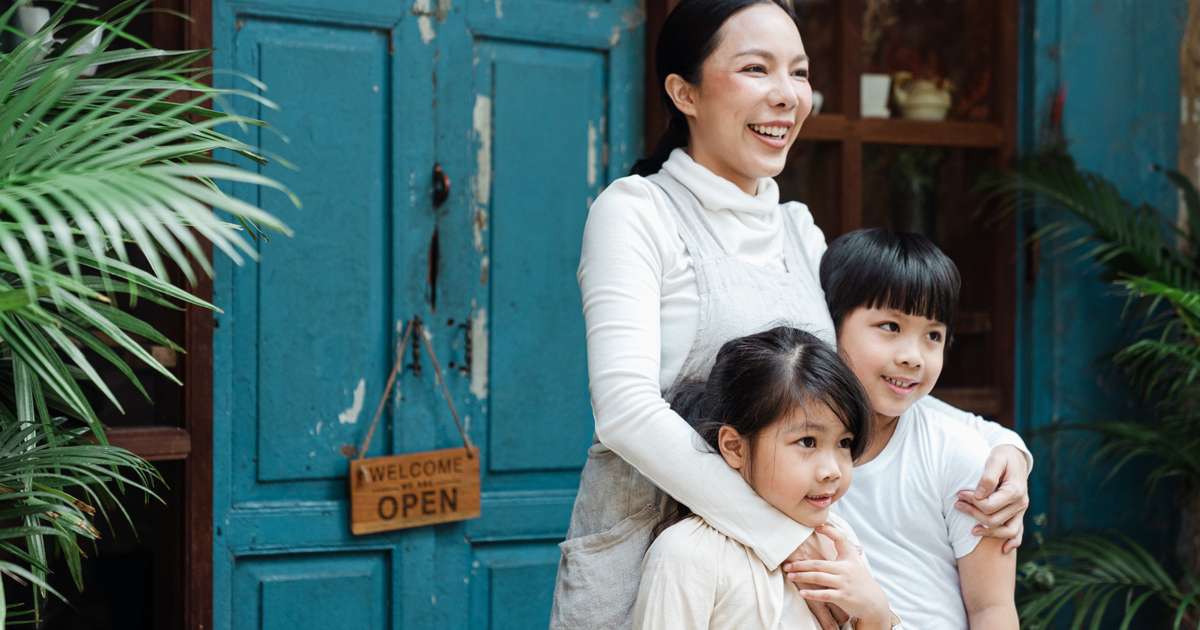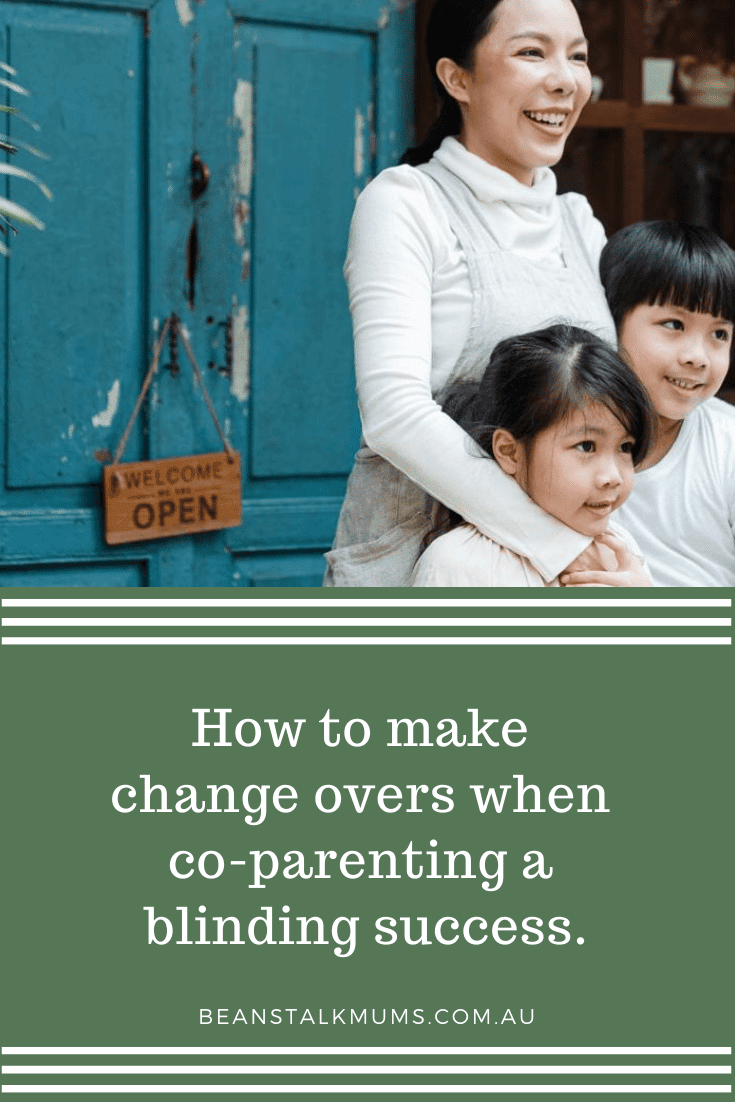
What is it that enables some couples to find peace and synergy in a broken relationship, while others drown in the stress of weekly change overs and ever-changing routines.
The changing family dynamic ultimately requires conscious-minded decision making to enable the children to feel safe in their new situation. However, every family has different circumstances as to they arrived at their break-up. With this in mind, there can be no one-size-fits all solution for everyone when it comes to changeover days. Rather, it is about learning a new way of thought and therefore action that can help each family reach their own rhythm of what works.
As a mum-of-four and having been in the relationship at a young age, exiting the marriage was one of my life’s most defining experiences. Regardless of what was going on for me mentally and emotionally, my focus was ensuring my children felt emotionally supported.
Further reading: Using a third party for changeover with shared parenting.
My Experience with Changeover
It was so tempting to ask my 10 and 12-year-old what was going on at the “other” house. How was their routine, what did they eat for dinner? What was bedtime routine like? Did they brush their teeth? Yet, I bit my tongue because I didn’t want them to feel pressure of being interrogated and having to come up with an answer that wouldn’t “upset mum”. I’m proud that I did that. There is so much freedom and sense of peace that comes from letting go of the need to control or manage other people’s feelings and emotions.
The realisation that all I can do is merely be in charge of my own thoughts, words and actions is comforting and oddly not as hard as I once thought it might be. Mirjana, 52, divorced for five years, separated for six and co-parenting two daughters who spend time with their dad each fortnight and more during school holidays. With my two eldest children now grown, it has reached another dynamic, one that I continually grow with.
Divorce has been one of the most stressful transitions I’ve been through, not to mention the changeover required. Fortunately, I have more awareness now and am excited to share my experience and understandings which hopefully makes it easier for you to navigate your personal situation.
Changeover Considerations
- Confirm with their dad the exact time and details for handover, that is, is he dropping them off, or am I? Also, consider any special requirements needed for the stay.
- Go over any routines, extracurricular activities, homework routines, appointments etc.
- Communicate with your ex and prepare the children for the transition.
- Show excitement – be in ease and flow and let go of attachments
- Ensure and check off against the checklist of what they may need for the stay
- Meet and greet their dad, have a pleasant exchange of conversation
Embracing Change and The Changeover
If you’re reading this, you likely know all too well that moment when you knew the family dynamic was about to change, navigating everyone’s feelings and emotions, least your own. What I have learned through my own experiences of separation and divorce, is that it’s about being fully present in the now and this includes the regular drop offs and pick-ups. This essentially means we become emotionally conscious and unafraid to share how we feel.
Children respond to the emotions of parents. If you are anxious during this period of drop offs and pick-ups, it helps to share this with your children as, more often than not, unspoken words get left to interpretation. It’s important not to allow your emotions and feelings to keep you stuck in victim mentality or become abusive and speak negatively about your ex-partner. If you are hurt or angry, it is best to find a safe space in order to vent and expunge those feelings. It is critical to not do this with the children.
Here are some tips that worked for me around the whole changeover reality and still bring balance today. The ripple effect of such a routine is everyone benefits. Look after your emotional and physical needs, so you have the blessing of self-support that then impacts those around you.
Acknowledge Your Emotions
Changeover can trigger many emotions. It’s not uncommon for them to build up and leave you feeling emotionally drained. It’s important for you to take responsibility for your own emotional well-being at this time and make sure that you nurture yourself emotionally, physically and spiritually.
Self-Care
Self-care is essential to a positive mindset and this relieves the symptoms of stress during time of changeover. Nothing helps our emotions bounce back better than nourishing our body well. Read, get plenty of rest, take a hot bath, develop a new hobby, eat healthy and nutritious foods and surround yourself with positive people. Put effort into living a lifestyle that will promote feelings of good self-worth and esteem during this time of changeover.
Let Go
If you are faced with an uncomfortable experience during changeover, learn to let it go. Take some time to figure out what is best for you and the child, then communicate that effectively. Stay focused on what you have control over and let go of the rest.
Permission to Feel
Emotions are normal, whether they are negative or positive. What we do with the emotions we are feeling plays a big role in our experience of the changeover.
Expect Nothing and Appreciate Everything
No one has any control over the feelings and actions of another person. We might think that during our relationship we had some control, but we did not. Now there is a changeover in process, we have even less control than before. Let go of trying to control any aspect of what your spouse may feel or what actions they will take. Let go of what you feel the outcome should be and learn to accept whatever might happen.
It’s about being tolerant whilst also maintaining effective communication and your boundaries.
Amicable Parenting During Hand Over
After separation and divorce, it took time for my two younger girls to get used to moving between two homes. In fact, they hated it at first and were very overwhelmed at the thought of living in two homes. What I found helped was to communicate clearly about the routine, where, how and when changeover will take place. Clear and predictable rules made it easier for them to cope with different routines and houses.
I also felt it was important to have the girls involved. Your child is likely to adjust better to living arrangements after separation or divorce if they feel like they have had some input and what they think matters. What I found worked for our family dynamic of co-parenting was to reassure our children that we would consider the living arrangements they want. You can involve them in the discussions if you think they are old enough.
Your child may worry they must make a choice that means pleasing one parent and hurting the other. It’s okay to reassure them and let them know that it’s not up to them to make the major decisions. Reassure your child that living arrangements aren’t about who loves your child the most. Rather, base them on practical issues like who is at home most, lives closest to school or can get to after school activities. The wellbeing of the child is paramount.
Where, How and When
When your child moves between homes, they might feel unsettled and grumpy when they first arrive. The good news is you can plan ahead for this unsettled period. Here are some tips that worked for us:
Organisation
Keep basic clothing and personal items like underwear, toiletries, pyjamas etc in each home. This way, your child doesn’t have to remember to move everything between the two homes.
To make things easier at packing time, help your child pack their changeover bag or write a list of what he needs to take and stick it on the wall. Older children might need help planning school routine and homework to take.
Two Homes, Two Routines
Children can cope well with different routines, as long as the rules are clear and you keep things as predictable as possible. You might need to say something like, “When you’re here, we’ll do it this way.” Eventually your child will get used to the differences.
A ‘Place for Me’
Children need a place of their own and a space to store things in both homes. Think outside the box a little, make it fun and exciting. Find a way to give your child some ‘me space’.
Listening
If your child is confused or anxious about moving between two homes, listen to what’s bothering them. You might need to talk to your former partner about the arrangements if they need changing to suit your child’s needs. Keep the lines of communication open.
Flexibility
A consistent and predictable routine helps children feel secure, confident and happy. But as your child gets older, they’ll have extra school, social, sport and even part-time work commitments. This might make it harder for them to move from one house to another. You might need to adjust your arrangements to your child’s changing needs.
What Works for My Family
- We have a homecoming ritual. It could be playing favourite music, dancing, playing a game, doing art, eating a snack together, or just sitting in the same room and chatting, telling stories and sharing feelings and emotions. This can help ease the transition.
- Give the children a chance to unwind. I take the cues from them about whether they’d prefer a quiet activity like reading a book, or something physical like outside play.
- I encourage them to keep in touch with their dad when they’re with me.
- If possible, I avoid making the transition or changeover when they are tired or hungry. It’s usually early morning or later afternoon.
- We have a circle of trust. Once we engage the circle of trust, we are each free to speak as we feel and share without the feeling of being judged or overwhelmed or protective. It really has expanded our channels of communication.
What to Do When It’s Not Smooth Sailing
Some children have trouble moving between houses. Your child might decide they don’t want to go to your exes or come home to you. Try not to take this too personally. This feeling might go away once your child gets into the routine. For some, especially very young children, separation can be quite difficult.
If possible, try to work out a solution with your ex. You might need to look at your arrangements again, to make sure your child’s needs are being met. For example, you might need to change the time of day when the changeover is happening, the activities leading up to changeover, or where you do the changeover.
The foundation for effective communication after divorce and for changeover to be seamless is a commitment from you and your co-parent to raise your children together in a healthy environment free of conflict. Remembering this commitment can help you and your ex-partner reach an effective parenting partnership. With that commitment always in mind, you can turn your attention towards establishing the other building blocks of effective communication.
How to Best Communicate During Changeover
- Manage your own emotions, recognising if you lose control, matters will only get worse. You can do that through deep breathing, relaxation techniques or just telling yourself that by remaining calm yourself, things may go better.
- Plan the timing of your communications to occur when neither of you have the kids around and you are both free of distractions.
- Remain polite and respectful no matter what. Speak how you would want to be spoken to.
- Chose the right medium for communicating. That can be face-to-face, telephone, messaging, email or a communication book.
- Keep your communication brief and only about the matter at hand. If you go on a tangent, it can be a slippery slope to topics you may not appreciate. If your ex goes to topics you are uncomfortable with, indicate so and ask to either change the subject or reschedule the call to when you are prepared to address the issue.
How Conscious Parenting Fits into the Divorce Picture (and hand over)
Children do not thrive emotionally or truly feel “at home” when exposed to chronic conflict, estrangement between parents, or disengaged and dysfunctional role modelling. This is where conscious parenting comes into play when moving into the phase of successful changeover.
The primary goal of a smooth changeover is to create a foundation for your child to become at ease, well-adjusted, independent, confident and a happy and connected person. If changeover is handled with mutual compassion, grace, respect and patience, the experience of moving through it can offer your children tools to help them navigate future trials and tribulations, skills for problem-solving, conflict management, mindfulness and resilience.
Co-parenting and changeover is often assumed to be contentious for the parents. Once you’ve lived life as a family under one roof, co-parenting while physically separated can feel overwhelming and it can also be hard to imagine working together in a way that does not compromise consistency, security and connection with your children. Each person has the power to choose a conscious co-parenting partnership and conscious process of changeover that reflects and expresses their best self. I’m always reminded that my ex-husband and I will see each other in a fortnight at the changeover. It can be hard or easy, discourteous or respectful, rigid or compromising. For all concerned parties, it’s a conscious choice to take the high road.














